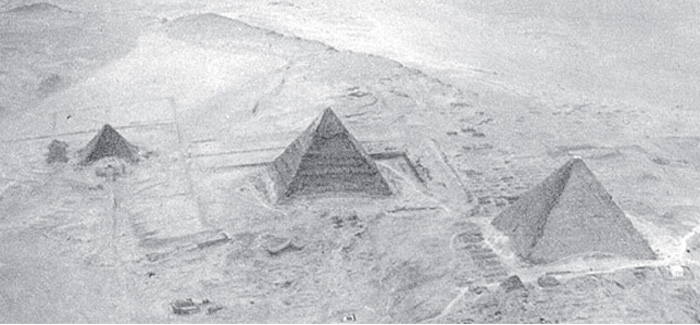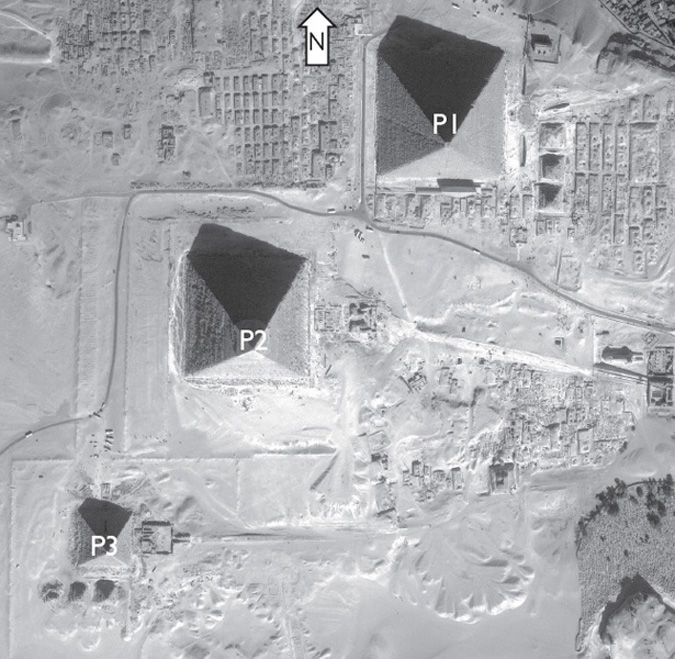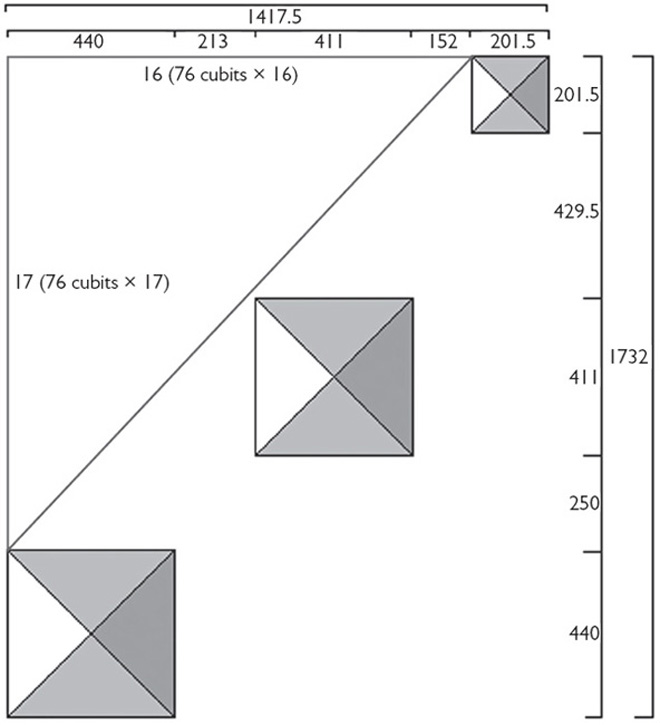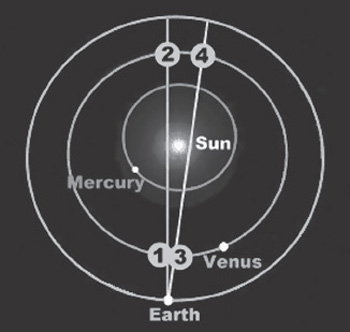8
• • • • • • •
The Giza Pyramids Represent the Three Inner Planets
The notion that the pyramid builders designed the Giza Plateau layout to reflect the appearance of the Orion constellation was first proposed by Robert Bauval, the coauthor with Adrian Gilbert of The Orion Mystery. The theory has been a source of debate ever since.
However, even though that argument appears to hold water, I am going to propose that an equally or even more important set of relationships, earthbound ones, are embodied by the Giza pyramids.
If the three pyramids on the Giza Plateau were converted into spheres, it would be obvious that they would resemble the relative sizes of Earth, Venus, and Mercury to the naked eye.
But their pyramidal shape somewhat conceals this fact. The comparative astronomical data presented below, however, show that the dimensions of the pyramids do very closely approximate those of the inner planets.
The dimensions are so close, in fact, that in many cases the deviations are not significant enough to discredit the data, even on a strictly scientific basis. No such careful scrutiny is allowed by the nebulous, cosmic-based Orion theory. In fact, I see this not as an either-or choice, but as that of both-and . . .
The following dataset shows that various measurements of the three pyramids relate in ratios with the ratios between similar measurements of Earth, Venus, and Mercury, in a number of ways that far exceed chance.

Fig. 8.1. The pyramids of Giza

Fig. 8.2. An aerial view indicating the size of the three pyramids of Giza. P1 represents Earth, P2 is Venus, and P3 represents Mercury.
The Area of the First Pyramid vs. the Second Pyramid
- The area of the base of the first pyramid covers 13.6 acres.
- The area of the base of the second pyramid covers 11 acres.
- This shows that the second pyramid has 82 percent the area of the first.
The Mass of Earth vs. Venus
- The mass of Earth is 5.972 × 1024 kilograms.
- The mass of Venus is 4.8685 × 1024 kilograms.
- This shows that Venus has 81.5 percent the mass of Earth.
The Length of the Sides of the Second vs. the First Pyramid
- The length of each side of the second pyramid is 706 feet.
- The length of each side of the first pyramid is 755 feet.
- This shows that each side of the second pyramid is 95 percent the length of each side of the first pyramid.
The Diameter of Venus vs. Earth
- The diameter of Venus is 12,100 kilometers.
- The diameter of Earth is 12,752 kilometers.
- This shows that the diameter of Venus is 95 percent that of Earth.
The Height of the Second Pyramid vs. the First Pyramid
- The height of the second pyramid is 448 feet.
- The height of the first pyramid is 481 feet.
- This shows that the second pyramid has 93.13 percent of the height of the first pyramid.
- The Diameter of Venus vs. Earth
- The radius of Venus is 6,052 kilometers.
- The radius of Earth is 6,381 kilometers.
- This shows that Venus has 95 percent of the radius of Earth.
The Volume of the Second Pyramid vs. the First Pyramid
- The volume of the second pyramid is 15.417 million cubic royal cubits.
- The volume of the first pyramid is 18.023 million cubic royal cubits.
- This shows that the second pyramid has 85 percent of the volume of the first pyramid.
The Volume of Venus vs. Earth
- The volume of Venus is 9.28 × 1011 kilometers.
- The volume of Earth is 10.832 × 1011 kilometers.
- This shows that Venus has 85 percent of the volume of Earth.
The foregoing comparisons of the two pyramids’ basic measurements with the two planets clearly reveal that the Great Pyramid represents Earth and the second pyramid represents Venus. In fact, there is extremely little deviation when the immense dimensions involved are factored in.
The orbital period of Venus is 225 days, which, compared with Earth’s, which is 365, come out to 61.5 percent that of Earth, or 0.615, which is phi. This means that Venus revolves around the sun in 225 days, Earth in 365; the former then moves around the sun 1.6 times faster than Earth.
The matches between the measurements of the first and second pyramids and those of Earth and Venus are very precise. It is also clear that the phi approximations were intended, as all three pyramids display this feature.
The Area of the Base of the Third Pyramid vs. the First Pyramid
- The area of the base of the third pyramid is 5.2 acres.
- The area of the base of the first pyramid is 11 acres.
- This shows that the area of the base of the third pyramid is 47 percent of the area of the base of the first pyramid.
The Diameter of Mercury vs. Earth
- The diameter of Mercury is 4,879 kilometers.
- The diameter of Earth is 12,765 kilometers.
- This shows that the diameter of Mercury is 38 percent that of Earth.
The Length of the Third Pyramid vs. the First Pyramid
- The length of each side of the third pyramid is 339 feet.
- The length of each side of the first pyramid is 755 feet.
- This shows that the length of the third pyramid is 44.9 percent of the length of the first pyramid.
The Radius of Mercury vs. Earth
- The radius of Mercury is 2,439.7 kilometers.
- The radius of Earth is 6,381 kilometers.
- This shows that Mercury’s radius is 38 percent that of Earth’s.
The Height of the First Pyramid vs. the Third Pyramid
- The height of the third pyramid is 215 feet.
- The height of the first pyramid is 481 feet.
- This shows that the third pyramid is 44.69 percent the height of the first pyramid.
The comparisons between Mercury and Earth and the third and first pyramids are admittedly not as exact as those between Earth and Venus and the second and Great Pyramid.
However, there is no question as to the overall effect of the Giza site; it looks like a pyramidal model of the three inner planets, and that effect is confirmed by comparing the measurements with the matching planetary data.
The base-to-height ratio of the third pyramid is also the same—1.575—as the other two pyramids.
There is a vast amount of data contained within the Giza pyramids. How that portion presented above will be disputed and rejected by orthodox historians is fully anticipated by me. Their main objection will be to the notion that the ancient Egyptians possessed any knowledge of the specific planetary information given. That, of course, was only obtained in modern times using advanced technologies.
However true those points may be, they are simply not relevant to the theory presented in this series. The reason that the ancient artifacts of Egypt pose so many enigmas is that they are attributed to the Egyptian human culture that is known to have existed 2,000 to 4,500 years ago.
It is all but impossible to show how that culture, without the benefit of the wheel and horses, or pulleys, hoists, cranes, and front-end loaders could build a multimillion-ton, forty-eight-story high structure. That is a feat today’s architects, engineers, and contractors with the aid of modern machinery would have difficulty duplicating now, at this late date in history.
But orthodox historians continue to try to fit this square peg into the round hole, and it never works; the enigmas persist, yet they try to pretend otherwise. The end result is a distortion of the facts, irrational theories, and outright disinformation.
Next, they will reject the notion that the Giza complex was based on a carefully thought out master plan. Their notion is that the precinct was developed haphazardly, in piecemeal fashion, by succeeding generations of pharaohs.
But we must ask, Why are the first and second pyramids so very close in size and the third is a dwarf by comparison? Did the alleged builder of the third, Pharaoh Menkaure, feel so dwarfed and overshadowed by his predecessors that all he could do was build a mere model of their immense structures?
Again, are the exact parallels between the first and second pyramids and Earth and Venus mere accidents? In fact, does it not make more sense to assume that the third pyramid is so small because it is a nearly exact model of Mercury’s size relative to Venus and Earth?
Orthodox historians have to routinely resort to the concepts of “accidental” and “coincidental” when trying to explain many features of the Great Pyramid. How did the builders so precisely orient the base to the cardinal points? No ancient cultures were supposed to have knowledge of true north back then.
But as we saw in chapter 3, the builders knew a lot more about Earth’s geography than true north. Of course, the fact that the pyramid sits on a meridian that just happens to be 120° from the Mississippi River and 90° from the Yangtze River will, no doubt, be dismissed as a mere coincidence.
In fact, orthodox historians have backed themselves into a corner, an intellectual reality that will be made very clear in the following chapters.
An advanced extraterrestrial civilization would have all this knowledge and far more. The expected objections are irrelevant. Historians are operating within the context of their own self-imposed limitations and preconceptions.
In truth, it is not outside the realms of physics or astronomy to consider the possibility that such a zero-point civilization designed and built the Giza complex. To dismiss the idea out of hand is to display an amazing degree of narrow-minded thinking. Are we not in the age of technological marvels and space exploration, after all?
In the preceding section, we saw that the pyramids display a very high degree of similarity to the three inner planets when considering their most basic three-dimensional measurements.
THE SITE PLAN AND THE DISTANCES BETWEEN THE INNER PLANETS
By placing the three Giza pyramids in exact predesignated locations and building each pyramid to a specific size of base and height, the builders constructed a representation of Earth, Venus, and Mercury, as well as making them the key geodetic marker.
In this context, we assume that the designers and engineers worked from a master blueprint. The precinct was not designed on the fly by succeeding pharaohs. The plan was fully created beforehand and then executed.
Now, turning to the relationship of the layout of the Giza site plan and the relative positions of the pyramids we find the following:
Sir William Flinders Petrie was a pioneering English Egyptologist who excavated many important ancient sites and was the author of the important text The Pyramids and Temples of Gizeh. Petrie took extensive measurements of nearly every feature of the pyramid, including the distances between them. Using Petrie’s measurements,1 John Legon, an independent Egyptologist and researcher, diagrammed the three main pyramids at Giza2 as shown in figure 8.3.
Legon’s diagram clearly shows that the original architects and engineers had a survey sight line. That line extends from the northwest corner of the Great Pyramid to the northwest corner of the second pyramid, then to the northwest corner of the third pyramid.
There was a generally accepted misconception (still accepted?) that the three pyramids were out of alignment. That notion was based on the assumption that the centers of the three should be in alignment.

Fig. 8.3. Based on William Petrie’s measurements, John Legon diagrammed the three main pyramids of Giza.
But who said that is what the builders wanted to achieve or should have achieved? The fact is that there is a straight-line alignment between the corners, as noted and shown above.
The next thing we note is that the first pyramid is closer to the second pyramid than the third is to the second pyramid. This is exactly what we would expect to find if the first pyramid represents Earth, the second, Venus, and the third, Mercury (see fig. 8.4).

Fig. 8.4. The orbital distances of the inner planets
Dear reader, I invite you to decide if the builders intended these relationships or if they are the result of random choices and chance.
The distance between the center of the second pyramid and the center of the first pyramid is 13,931 inches.
The distance between the center of the second pyramid and the center of the third pyramid is 15,170 inches.
In figure 8.3 a line is drawn connecting the apexes of each pyramid. This shows that while the builders used a straight sight line, they also wanted to convey curvature and movement. They achieved that by positing the third pyramid exactly where they did.
The top-down view suggests a curvature, which, of course, the orbits of the three planets follow.
The aerial photo of the Giza complex in figure 8.2 (where P1 is Earth, P2 is Venus, and P3 is Mercury) shows that the distances between the pyramids correlate with the relative average distances between the planets.
CONCLUSION
The three pyramids of the Giza complex reflect the ratios of the relative distances and sizes of the inner planets: Earth, Venus, and Mercury. This design feature adds greatly to the sophistication of the complex, which suggests that an advanced extraterrestrial civilization with accurate astronomical knowledge designed the complex.